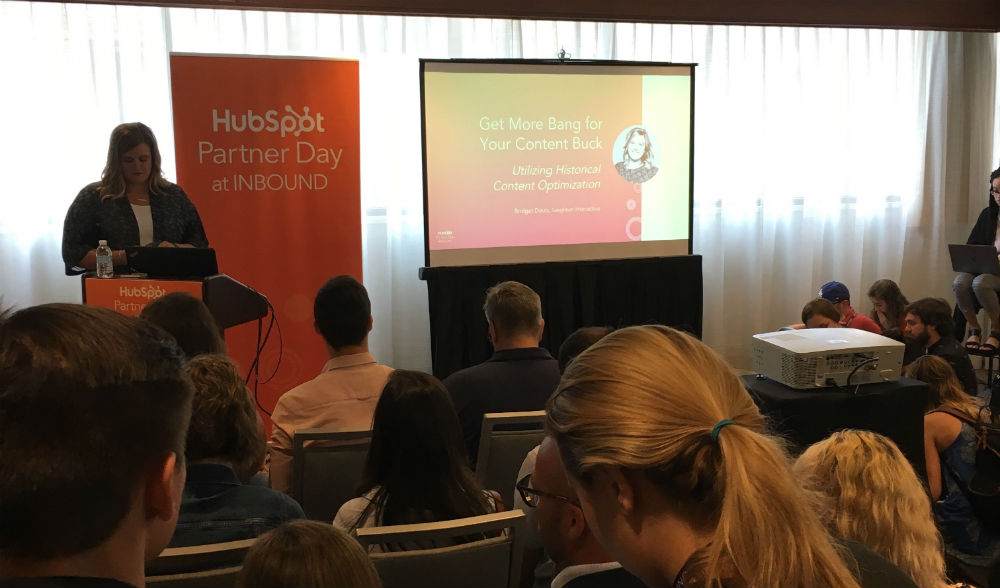Partner Day at INBOUND 2018 offered HubSpot agency partners the chance to hear from a number of marketing industry experts on a variety of topics. Content creation should be an extremely important part of any businesses marketing and sales strategy. It is vital for a website to rank in search engines and has to be engaging enough for a customer to stick around after finding your website and drive them into making a purchase of your product and/or service.
The main problem with creating content is that it’s time consuming. Very time consuming. A lot of resource has to go into creating great content again and again and again. It was for this reason that I decided to attend Bridget Deutz’s talk: ‘Get More Bang for Your Content Buck: Utilizing Historical Content Optimisation’. If you have invested time and money in creating content in the past, then it makes sense not to forget about it and use it to generate value today.
 What is Historical Content Optimisation?
What is Historical Content Optimisation?
Historical content optimisation is taking content you have previously posted and making it fresh, relevant and new once again.
The Benefits of Optimising Historical Content
Time is precious. Bridget explained how in a world where time is increasingly becoming more and more of a luxury, it is important to focus on working smarter, not harder. A blog that you research and wrote in the past can be reoptimized and this saves time.
To do this you should follow the ROPSTM process:
Rework – You should look for opportunities to refresh your historic content. This can be including CTAs, links, better images, new information from additional research and new up to date data.
Optimise – Take a look if the blog is ranking, where it is ranking and then decide whether it can be improved. There might be an opportunity to optimise it and gain a better ranking.
Publish – When you rework the content make sure that it is published again, so it appears at the top of your blog feed. This will make it more accessible and mean people are more likely to engage with the piece. Remember to fetch the URL in Google Search Console, so Google crawls the updated blog and takes into account the updates you’ve made.
Share – Make sure to promote the content across your platforms such as social media and email sends. If you identify pieces of content that are performing particularly well then you can even put some paid search or paid social budget behind that piece to extend its reach. If you have taken the time to repurpose a piece of content, then it is very important to be proactive and share it.
Identifying Historical Content Worth Optimising
The important thing is to identify which content pieces are most worthwhile investing the time to optimise and repurpose. According to Bridget there are 4 things you should keep in mind when making this decision:
- High view or high conversion rate
- Page ranking, both present and potential
- Keyword search volume
- Outdated or misguided information. Things change so make sure you update your blogs. You can even include in the title ‘Updated for 2018’ or ‘New and Improved’ to make it obvious to the reader that this is a fresh piece of content worthy of their time.
Merging Short Blog Posts
It is important to note that sometimes you can create a much better piece of content by combining old short blogs into one bigger more detailed blog. Merging content into one detailed piece of copy with lots of information can help it to rank better. Do not be afraid of your blogs being 1500 to 2000 words. As long as the content is high quality, delivering value for the user and requires that many words to truly address the topic, then a higher word count has value.
Creating one piece of detailed, highly informative content can help this piece to rank better in search engines.
Repurpose Your Content and See Results
Historical content optimisation can have results for your company. Review the current content on your website using the methods discussed above, identify content that can be repurposed and improve it. With tracking tools such as SEMrush, you will then be able to look 2-3 months down the line to see how this activity has impacted your contents rankings.
If done properly, then your content rankings should have improved, visibility of your website will have increased and you will have saved considerable time compared to if you were creating brand new content. It’s time to work smarter, not harder, when it comes to content creation.
If you would like to find out more about optimising your website content for search engines or help with your inbound marketing strategy, then speak to a member of our team.








